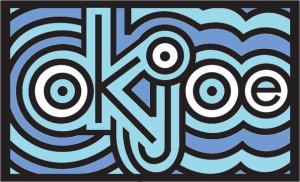Posts Tagged ‘arts’
Yes, I’m in senior seminar right now with Michael Fels. We have a really great, dynamic group that sparks awesome conversation, even at 8am. In the accompanying Advanced Projects in Kinetic Imaging class, I’m working on an interactive video installation right now describing the process Burlington-based TS Designs uses to create their sustainable t-shirts, all within North Carolina, “from dirt to shirt”. I’m a publicity intern for them right now, and have gotten really excited about learning how they can grow, harvest, gin, spin, weave, and print a line of shirts all in this state. I want to illustrate this sense of community and nurturing through my next piece, with interactive attributes, maybe including seed planting or miniature models.

This is a logo that Saragusa created for her best friend, Joe Slocum's vice-presidential campaign at Elon University.
If you could describe your art in one word, what would it be?
Playful. I’m still a little kid deep down. I find it impossible to envision myself as an adult. I don’t do dark art. I don’t do sad art. I can’t see the point in dwelling on negativity when positive solutions and optimistic viewpoints can always be found and highlighted no matter what your subject matter is. I think that’s important for artists to remember. Bad things in the world can always be shown from the doom and gloom perspective, but that seems to be the easy way to go. Creative problem solving is very much needed in our world, and artists aren’t just pretty picture makers. We can be activists and educators, too.
How long have you been interested in art?
I have been telling stories and writing books and illustrating since I could hold a crayon. I am a very narrative-oriented person. If you sit down with me and let me tell stories all day, I will. I find that I can relate to just about anyone based on experiences, down to a very intimate level, just by exchanging life stories. This is very prominent in my art. I think it’s just an integral part of my personality to attempt to express myself in a non-verbal way. My friends’ and family’s ears need a break every now and then.
When I applied to Elon, I had no intention of becoming an Art Major. I aimed to be a part of the Athletic Training program, but that was eliminated and turned into the Exercise Sports Science program in 2007, a major not under the umbrella of the Elon College Fellows program to which I had been accepted. A little dejected, I was like “Hell, let’s give this art thing a shot.”
Where do you get your inspiration from?
My inspiration comes from dreams a lot of the time. I have incredibly vivid dreams that I write down in full detail in a very hidden place. My imagination generates millions of ideas and images every day and I hate the fact that I can’t write or draw all of them, but such is life. Like I was saying, sustainability is something I’ve been working hard to completely integrate into my art, but I also am working towards incorporating it into my lifestyle in my clothing, food, and recreational choices.
People inspiring me right now are eco-artists, like Lillian Ball, who just recently visited Elon last week. She was awesome, a totally committed activist and artist and community member who does incredible things for plants, animals, AND people. She’s definitely a mover and a shaker in the environmental world that I look up to.
What would your dream art project be?
I want to build a food co-op/art gallery/sustainable clothing boutique/performance space…all in a tree house. I am going to do it one day. It’s pretty much my ultimate goal in life. It encompasses literally everything I’m interested in: local food, community unification, sharing of art, dance and music, fashion, architecture, and being one with nature. I’m very Zen-minded, and developing this beautiful community space in and with the natural world would create a very positive energy and environment to foster these principles and ideas.
What are your plans as an art major following graduation?
I’m moving to California. There’s a lot of support for sustainability out West, not to mention my family has just moved to the San Francisco area, and graduation cannot come fast enough. I don’t want to wish away my senior year, but I’m a go get ’em kind of girl and I want to make changes in the world and create and continue to grow, and in my opinion, the sooner the better.
What would you like to say about the Elon Art Department? How has it prepared you?
These are the greatest people you will ever meet. The faculty is amazing–incredibly talented and supportive, not to mention hilarious and extremely dynamic. We have young, digitally-minded faculty, more experienced, classically minded faculty, and the ideas and conversation you can find floating around the art department are truly engaging, sometimes challenging, and usually wild. The little family I’ve come to have in the art department fosters my growth and skill building as an artist. Even more importantly, my peers and professors make me a better human being.
N.C. Arts Council’s Museum in a Minute: Reynolda House Museum of American Art
Posted on: December 1, 2010
Opening as a public art museum in 1967, the Reynolda House Museum of American Art contains collections of renowned American art ranging from the colonial period to the present. The Reynolda House also possesses an impressive costume collection that includes 700 articles of clothing dating back to as early as 1890.
The Asheville Art Museum has been featured in the North Carolina Arts Council’s Museum in a Minute program.
The museum, which includes collections of studio craft, work by Black Mountain College artists and other leading regional and national artists, is located in the mountains of western North Carolina.
 The North Carolina Museum of Art, one of the most distinguished museum in the South, recently completed a significant three-year expansion and reopened to the public on April 24, 2010. Located in Raleigh on a 164-acre park, the museum seamlessly blends art, architecture and nature.
The North Carolina Museum of Art, one of the most distinguished museum in the South, recently completed a significant three-year expansion and reopened to the public on April 24, 2010. Located in Raleigh on a 164-acre park, the museum seamlessly blends art, architecture and nature.
The museum first opened to the public in 1956 in a renovated state office building in downtown Raleigh. Since its inception, the museum’s collection has grown to include European paintings from the Renaissance to the 19th century, Egyptian art, sculptures and vase paintings from ancient Greece and Rome, American art from the 18th to 20th centuries and international contemporary art, as well as various others. Click the image to the left or follow this link to view a slideshow of samples from the collections.
Admission to the Museum’s permanent collection and Museum Park is free; however, there is a charge for some special exhibitions.
The Wilmington area is expected to fully develop a local arts council by the end of 2011. Its predecessor, the Arts Council of Lower Cape Fear, was forced to close its doors in 2002 due to financial difficulties.
Nevertheless, a steering committee in collaboration with staff of the N.C. Arts Council has released a report that details the steps left to take to make a council a reality. Financial backers seem optimistic about the plans.
“We have so many people here who are passionate about their art, but there is no real channel for their creativity. It needs to be fostered,” said Kim Adams, of Wilmington’s Development Services department and a steering committee member.
The Carrabus Arts Council–who provide grassroots arts grants–has awarded $22,910 in grants to 11 community organizations for art programs or activities that enhance the quality of life in Carrabus County.
According to Noelle Rhodes Scott, president and CEO of the Cabarrus Arts Council, “It is this beautiful network of arts councils and Grassroots funding that has given North Carolina its great reputation as a state filled with the cultural arts.”
Art outings around Asheville
Posted on: October 23, 2010
The Asheville Citizen-Times has compiled a brief list of opportunities for art lovers in Asheville that will run from now until late November. Artists range from a North Carolina native to French painter Jean Claude Roy.
 In a time when drawing may seem slow and tedious, The Green Hill Center for North Carolina Art in Greensboro is currently hosting an exhibit entitled Drawing Revisited, which surveys North Carolina artists working in mediums such as graphite, ball point ink and conté crayon.
In a time when drawing may seem slow and tedious, The Green Hill Center for North Carolina Art in Greensboro is currently hosting an exhibit entitled Drawing Revisited, which surveys North Carolina artists working in mediums such as graphite, ball point ink and conté crayon.
The exhibition will run until Oct. 31–visit the site for more information.
Located on the University of North Carolina Greensboro campus, the Weatherspoon Art Museum was founded in 1941 and has since grown from a university teaching gallery to a full scale art museum including collections of modern and contemporary art.
The North Carolina Museum of Art is attempting to feature an exhibit in October 2011 that contains more authentic Rembrandt paintings than any American museum.
Located in Raleigh, N.C., the museum is borrowing Rembrandt pieces from nearly two dozen museums across the United States, such as the National Gallery of Art in Washington and the Metropolitan Museum of Art in New York. The total value of the exhibit is undisclosed, but according to museum officials, it will “exceed anything the museum has put together before, including blockbuster exhibitions of Picasso, Matisse Monet and Rodin.”

